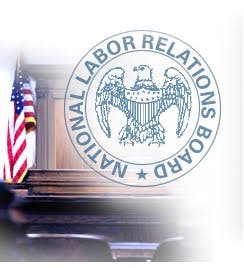By James M. Walters
Last Friday, the U.S. Court of Appeals for the District of Columbia Circuit issued a long-awaited ruling refusing to enforce the National Labor Relations Board’s bargaining order against a petitioning employer. The basis for the court’s decision was the improper appointment of three members of the NLRB (see Noel Canning v. NLRB).
The Appeals Court opinion was authored by Chief Judge David Sentelle, and joined by Judge Karen LeCraft Henderson and Judge Thomas Griffith (who concurred in the opinion). This decision was unique, in that it was ultimately decided on purely constitutional grounds, holding that President Barack Obama’s attempted recess appointments of three NLRB members in January of 2012 were constitutionally impermissible.
Why the Court ruled the way it did
After perfunctorily finding that it could not overturn the Board’s Order on statutory grounds, it vacated the Order because the appointments were:
- “Made when the Senate was not in recess,” and;
- For “vacancies…[that] did not ‘happen during the Recess of the Senate’ as required by [Article II of] the Constitution.”
(Judge Griffith found it unnecessary to pass on point two of Noel Canning’s constitutional argument). Citing the 2010 decision of the U.S. Supreme Court in New Process Steel v. NLRB, the D.C. Circuit found that without a proper quorum “the order under review is void ab initio [from the beginning].”
What does this mean for the NLRB and for cases pending before it?
Although NLRB Chairman Mark Pearce (a non-affected appointee) issued a terse and somewhat defiant press release late Friday afternoon, the NLRB should be very concerned about its short-term prospects. This case is not just another iteration of New Process Steel, threatening the same decision-shredding result, but is one woven in far more serious fabric, factually, politically, and legally.
Getting behind the decision
The facts giving rise to the loss of a quorum at the end of 2007 were the result of Congressional gridlock, not Presidential preemption. When Senate Democrats, in the fall of 2007, threatened then-President Bush with 1) no more NLRB nominations advancing out of the Health, Education, Labor and Pensions (HELP) Committee, and 2) no congressional recesses for the foreseeable future, the White House took those at face value and neither nominated any Board Members nor attempted between-session recess appointments.
In what appeared to be simply a noble effort to keep the NLRB functioning the Board delegated its powers to Member Peter Kirsanow (R), a recess appointee whose term expired on December 31, and to confirmed Members Wilma Liebman (D) and Peter Schaumber (R) whose terms extended into subsequent years. The fact that the extant Members were of opposite political parties left the Board in a state of apparent equipoise, able to issue hundreds of “unanimous” 2-0 Orders, which were ultimately invalidated by the Supreme Court in June of 2010.
But recovery from the Supreme Court’s sting was quick, with Liebman and Schaumber still on the Board and with two new Members confirmed (plus one more recess appointment), the suddenly full-strength NLRB simply added a new member to the “rump panel” of the original decisions and managed to rubber-stamp many of the disputed Orders – at a record-setting pace – with the same result. That won’t happen with this judicial setback.
Assuming that the recess appointments remain invalid, the only legitimate Board Member left is Chairman Pearce, and his term may expire before the Supreme Court has a chance (as it surely will) to decide this case. With no “rump panel” to remand cases to, and Congress in all probability not going into recess any time soon, things look fairly bleak for the this government agency at this point.
What happens next?
One other factor differentiating Noel Canning from New Process Steel is the thrust of the argument: the latter was decided on statutory grounds – Section 3(b) of the National Labor Relations Act – while the former was decided on the more elevated constitutional grounds. While federal statutory construction may often be the province of the federal judiciary, interpretation of the U.S. Constitution is always directly in its wheelhouse.
Lastly, it should not be forgotten that the author of the 2009 Court of Appeals decision first invalidating the so-called “Two-Member Board” orders was the same Chief Judge Sentelle from the D.C. Circuit (in Laurel Baye Healthcare).
In the year in question, the Board has only issued slightly more than 200 Published Orders (significantly fewer than in the last ‘non-quorum’ period of 2008-2010), but the Board has already threatened to dig a deeper hole by promising to “continue to perform our statutory duties and issue decisions.”
Stay tuned.
This was originally published on Fisher & Phillips’ Legal Alerts. This Legal Alert is intended to provide an overview of an important new law. It is not intended to be, nor should it be construed as, legal advice for any particular fact situation.
